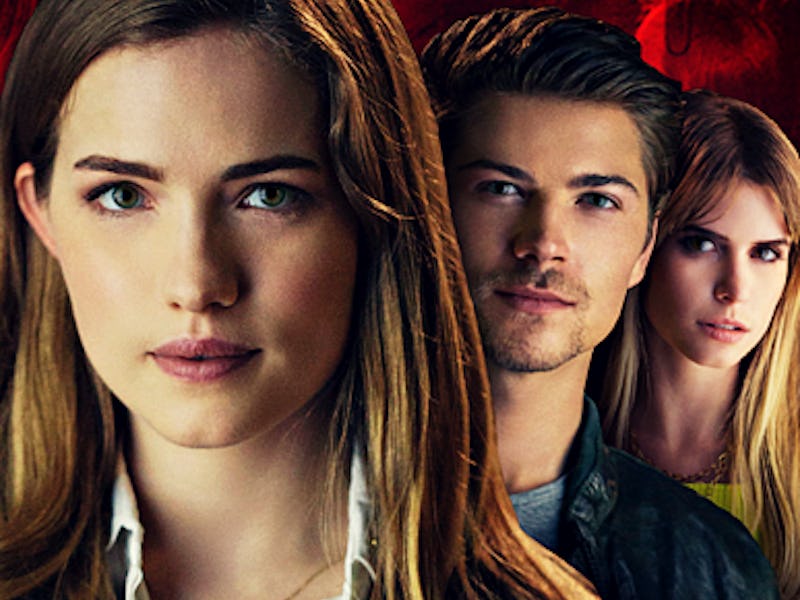MTV’s 'Scream's Charming, Garbled Collage
Episodes 1 and 2 suggest that the show could go interesting "whodunit"-like directions, but risks tediousness.

In 1985, avant-garde composer John Cage wrote an organ piece called “ASLSP,” which included the directive, “Play as slowly as possible.” After Cage’s death, a group of scholars took this cue to heart, starting a performance of the piece (which originally lasted 20 to 70 minutes) that is slated to go on for 639 years.
This is not quite the scale on which MTV’s new serial Scream series is working with the slasher film genre, but the impetus is similar. “You can’t do a slasher movie as a TV series,” Noah Foster (John Karna)— at once a token class nerd, horror movie obsessive and “Will Graham”-like serial killer empathizer — opines in the show’s pilot, against a dramatic, Philip Glass-esque orchestral soundtrack. “90 minutes later, the sun comes up as survivor-girl is sitting in the back of the ambulance watching her friends’ bodies being wheeled past. Slasher movies burn bright and fast; TV needs to stretch things out.” This speech — so far the most heavy-handed meta moment of the series — feels like a self-effacing plea for approval. To be sure, telling a ten-part, 42-minute-episode slasher story at the TV-14 level is a risky venture. Ultimately, Scream probably needs to coming into its own as something more.
It has, in a way. The show is equally, or even better suited, to fans of Degrassi or late-’90s camp in the broader sense (primetime WB dramas all the way to I Know What You Did Last Summer) than aficionados of modern-day horror television like American Horror Story or the soon-to-be late Hannibal. The gore quotient in Scream does not even approach that of those shows, and there is none of the highbrow structural innovation. Neither should there be; that would not be in the spirit of the original movies, which were teen ensemble dramadies as much as anything else (though ones you had to sneak into). Wes Craven and the gang kept the stakes low, the laughs steady, and the scares silly but effective.
Like the original movies (and the beloved AHS, from which Scream takes its most contemporary cues), there are plenty of references to horror genre archetypes and even specific franchises. The central, perhaps-reincarnated villain presiding over the action, Brandon James, combines a Jason Voorhees-like backstory and Michael Myers scare tactics: He drowned in a pond (and it seems they didn’t find the body?) and used to wear a white mask because of facial deformities. He took revenge on his high school bullies and then killed himself after being turned down by the woman he loved, “Daisy” (secretly, the mother of the show’s female protagonist, played by Tracy Middendorf). Now, it seems someone has returned to Lakewood to avenge James’ legacy, though we don’t know exactly why; that’s being rolled out irritatingly slowly.
Two deaths have occurred — so far, the opening house invasion scene of Episode 1 is the uncontested highlight of the show — and over twice as many fakeouts. Particularly effective is the ominous luxury sedan that turns on by itself in Brooke Maddox’s (the “rich bitch” character) garage, and the box containing an unidentified animal heart that’s delivered to the doorstep of Brandon James’ now-middle-aged former squeeze. There’s also a side conflict strikingly similar to recent screen-cap-based thriller Unfriended: The high school’s outcast is outed as bicurious in a video that goes viral among the student body, and shamed by the popular crowd. The guilty parties include, by proxy, her former-best-friend-turned-class-sweetheart Emma Duvall (Willa Fitzgerald) — the show’s main character and golden heart — who allowed the video to be posted, and cameraman Nina Patterson (Bella Thorne), who is killed in the first few minutes of the pilot.
Other big events center around modern technology; “GIF” creeps into the script a few times after the killer (or one of them) sends a Gossip Girl-esque text blast with a quivering image of himself captioned “PAYBACK’S A BITCH.” Mystically, texts and DMs are sent from characters’ phones without their knowledge. Then there’s the insensitive, bull-headed jock and his obsession with the town’s murders trending stats; also, he’s revealed to have had hidden candid cams in one of the dead girl’s homes. Hilariously, there’s even a parodic Sarah Koenig character hanging around to make an invasive podcast about the killings called Autopsy of a Murder.
Without delving into the details too much more, let it suffice to say that Scream is a messy ratking of plotlines right now. We’re not quite at the point of, as Noah puts it, “caring” about the characters, though that is certainly part of the end goal. One worries if that doesn’t start to kick in soon, the horrible or heroic things that all these teenagers-who-look-28 will eventually do might not make any sense, or work dramatically. The pacing of the show is also a bit strange; we pull back quickly from good scares and things we want to know more about (the past of Brandon James and Emma’s mom, the creepy but handsome sheriff’s son who namedrops Horace Walpole towards mundanity and side romance plots.
“The whodunit may not be as important in our story… you need to forget it’s a horror story,” Noah explains to his burgeoning new love interest, side-popular-girl Riley, who is nonsensically gleeful when talking about the town’s tragedies. First, though, we have to hone in a bit more on what the story is. It’s got all of the sprawling setup of an Agatha Christie novel — everyone’s a suspect. Ultimately, there will be plenty of twists and red herrings. But that thing that hooks you enough to keep watching a show like this — the moment where the caricatures start to turn into meaningful forces — hasn’t happened yet. At this point, however, it feels worth tagging along for at least a little while longer.